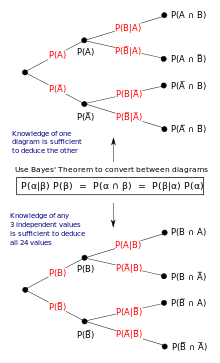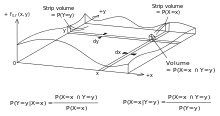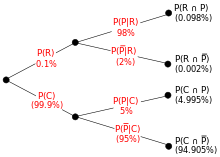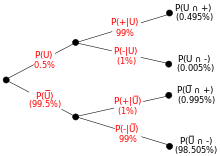Bayes' theorem
This article may be too technical for most readers to understand. (December 2011) |

| Part of a series on |
| Bayesian statistics |
|---|
| Posterior = Likelihood × Prior ÷ Evidence |
| Background |
| Model building |
| Posterior approximation |
| Estimators |
| Evidence approximation |
| Model evaluation |
In probability theory and statistics, Bayes's theorem (alternatively Bayes's law or Bayes's rule) is a theorem with two distinct interpretations. In the Bayesian interpretation, it expresses how a subjective degree of belief should rationally change to account for evidence. In the frequentist interpretation, it relates inverse representations of the probabilities concerning two events. In the Bayesian interpretation, Bayes' theorem is fundamental to Bayesian statistics, and has applications in fields including science, engineering, medicine and law. The application of Bayes' theorem to update beliefs is called Bayesian inference.
Bayes' theorem is named for Thomas Bayes (/ˈbeɪz/), who first suggested using the theorem to update beliefs. However, his work was published posthumously. His ideas gained limited exposure until they were independently rediscovered and further developed by Laplace, who first published the modern formulation in his 1812 Théorie analytique des probabilités. Until the second half of the 20th century, the Bayesian interpretation attracted widespread dissent[citation needed] from the mathematics community who generally held frequentist views,[citation needed] rejecting Bayesianism as unscientific. However, it is now widely accepted. This may have been due to the development of computing, which enabled the successful application of Bayesianism to many complex problems.[1]
Introductory example
If someone told you he had a nice conversation in the train, the probability it was a woman he spoke with is 50%. If he told you the person he spoke to was going to visit a quilt exhibition, it is far more likely than 50% it is a woman. Call the event he spoke to a woman, and the event "a visitor of the quilt exhibition". Then: , but with the knowledge of the updated value is that may be calculated with Bayes' formula as:
in which (man) is the complement of . As and , the updated value will be quite close to 1.
Statement and interpretation
Mathematically, Bayes' theorem gives the relationship between the probabilities of and , and , and the conditional probabilities of given and given , and . In its most common form, it is:
The meaning of this statement depends on the interpretation of probability ascribed to the terms:
Bayesian interpretation
In the Bayesian (or epistemological) interpretation, probability measures a degree of belief. Bayes' theorem then links the degree of belief in a proposition before and after accounting for evidence. For example, suppose somebody proposes that a biased coin is twice as likely to land heads than tails. Degree of belief in this might initially be 50%. The coin is then flipped a number of times to collect evidence. Belief may rise to 70% if the evidence supports the proposition.
For proposition and evidence ,
- , the prior, is the initial degree of belief in .
- , the posterior, is the degree of belief having accounted for .
- represents the support provides for .
For more on the application of Bayes' theorem under the Bayesian interpretation of probability, see Bayesian inference.
Frequentist interpretation

In the frequentist interpretation, probability is defined with respect to a large number of trials, each producing one outcome from a set of possible outcomes, . An event is a subset of . The probability of event , , is the proportion of trials producing an outcome in . Similarly for the probability of , . If we consider only trials in which occurs, the proportion in which also occurs is . If we consider only trials in which occurs, the proportion in which also occurs is . Bayes' theorem is a fixed relationship between these quantities.
This situation may be more fully visualised with tree diagrams, shown to the right. The two diagrams represent the same information in different ways. For example, suppose that is having a risk factor for a medical condition, and is having the condition. In a population, the proportion with the condition depends whether those with or without the risk factor are examined. The proportion having the risk factor depends whether those with or without the condition are examined. Bayes' theorem links these inverse representations.
Forms
For events
Simple form
For events and , provided that .
In a Bayesian inference step, the probability of evidence is constant for all models . The posterior may then be expressed as proportional to the numerator:
Extended form
Often, for some partition of the event space , the event space is given or conceptualized in terms of and . It is then useful to eliminate using the law of total probability:
In the special case of a binary partition,
Three or more events
Extensions to Bayes' theorem may be found for three or more events. For example, for three events, two possible tree diagrams branch in the order BCA and ABC. By repeatedly applying the definition of conditional probability:
As previously, the law of total probability may be substituted for unknown marginal probabilities.
For random variables

Consider a sample space generated by two random variables and . In principle, Bayes' theorem applies to the events and . However, terms become 0 at points where either variable has finite probability density. To remain useful, Bayes' theorem may be formulated in terms of the relevant densities (see Derivation).
Simple form
If is continuous and is discrete,
If is discrete and is continuous,
If both and are continuous,
Extended form

A continuous event space is often conceptualized in terms of the numerator terms. It is then useful to eliminate the denominator using the law of total probability. For , this becomes an integral:
Bayes' rule
Under the Bayesian interpretation of probability, Bayes' rule may be thought of as Bayes' theorem in odds form.
Where
Derivation
For general events
Bayes' theorem may be derived from the definition of conditional probability:
For random variables
For two continuous random variables and , Bayes' theorem may be analogously derived from the definition of conditional density:
Examples
Frequentist example

An entomologist spots what might be a rare subspecies of beetle, due to the pattern on its back. In the rare subspecies, 98% have the pattern. In the common subspecies, 5% have the pattern. The rare subspecies accounts for only 0.1% of the population. How likely is the beetle to be rare?
From the extended form of Bayes' theorem,
Drug testing

Suppose a drug test is 99% sensitive and 99% specific. That is, the test will produce 99% true positive results for drug users and 99% true negative results among non-drug users. Suppose that 0.5% of people are users of the drug. If an individual tests positive, what is the probability they are a user?
Despite the apparent accuracy of the test, if an individual tests positive, it is more likely that they do not use the drug than that they do.
This surprising result arises because the number of non-users is very large compared to the number of users, such that the number of false positives (0.995%) outweighs the number of true positives (0.495%). To use concrete numbers, if 1000 individuals are tested, there are expected to be 995 non-users and 5 users. From the 995 non-users, false positives are expected. From the 5 users, true positives are expected. Out of 15 positive results, only 5, about 33%, are genuine.
History
Bayes' theorem was named after the Reverend Thomas Bayes (1702–61), who studied how to compute a distribution for the probability parameter of a binomial distribution (in modern terminology). His friend Richard Price edited and presented this work in 1763, after Bayes' death, as An Essay towards solving a Problem in the Doctrine of Chances.[2] The French mathematician Pierre-Simon Laplace reproduced and extended Bayes' results in 1774, apparently quite unaware of Bayes' work.[3] Stephen Stigler suggested in 1983 that Bayes' theorem was discovered by Nicholas Saunderson some time before Bayes:[4] however, this interpretation has been disputed.[5]
Stephen Fienberg describes the evolution from "inverse probability" at the time of Bayes and Laplace, a term still used by Harold Jeffreys (1939), to "Bayesian" in the 1950s.[6] Ironically, Ronald A. Fisher introduced the "Bayesian" label in a derogatory sense[citation needed].
See also
- Dempster–Shafer theory – generalization of Bayes' theorem
Notes
- ^ McGrayne, Sharon Bertsch. (2011). The Theory That Would Not Die: How Bayes' Rule Cracked The Enigma Code, Hunted Down Russian Submarines, & Emerged Triumphant from Two Centuries of Controversy. New Haven: Yale University Press. 13-ISBN 9780300169690/10-ISBN 0300169698; OCLC 670481486 The Theory That Would Not Die, p. 10., p. 10, at Google Books
- ^
Bayes, Thomas, and Price, Richard (1763). "An Essay towards solving a Problem in the Doctrine of Chance. By the late Rev. Mr. Bayes, communicated by Mr. Price, in a letter to John Canton, M. A. and F. R. S." (PDF). Philosophical Transactions of the Royal Society of London. 53 (0): 370–418. doi:10.1098/rstl.1763.0053.
{{cite journal}}: CS1 maint: multiple names: authors list (link) - ^ Daston, Lorraine (1988). Classical Probability in the Enlightenment. Princeton Univ Press. p. 268. ISBN 0-691-08497-1.
- ^ Stigler, Stephen M. (1983), "Who Discovered Bayes' Theorem?" The American Statistician 37(4):290–296.
- ^ Edwards, A. W. F. (1986), "Is the Reference in Hartley (1749) to Bayesian Inference?", The American Statistician 40(2):109–110
- ^ Fienberg, Stephen E. (2006).When Did Bayesian Inference Become “Bayesian”?.
Further reading
- Pierre-Simon Laplace. (1774/1986), "Memoir on the Probability of the Causes of Events", Statistical Science 1(3):364–378.
- Stephen M. Stigler (1986), "Laplace's 1774 Memoir on Inverse Probability", Statistical Science 1(3):359–363.
- Bayes’ rule: A Tutorial Introduction by JV Stone.
External links
- Earliest Known Uses of Some of the Words of Mathematics (B). Contains origins of "Bayesian", "Bayes' Theorem", "Bayes Estimate/Risk/Solution", "Empirical Bayes", and "Bayes Factor".
- Bayesian Statistics summary from Scholarpedia.
- Weisstein, Eric W. "Bayes' Theorem". MathWorld.
- Bayes' theorem at PlanetMath.
- A tutorial on probability and Bayes’ theorem devised for Oxford University psychology students
- A graphical explanation of the Bayes theorem.
















































![{\displaystyle {\begin{aligned}P({\text{Rare}}|{\text{Pattern}})&={\frac {P({\text{Pattern}}|{\text{Rare}})P({\text{Rare}})}{P({\text{Pattern}}|{\text{Rare}})P({\text{Rare}})\,+\,P({\text{Pattern}}|{\text{Common}})P({\text{Common}})}}\\[8pt]&={\frac {0.98\times 0.001}{0.98\times 0.001+0.05\times 0.999}}\\[8pt]&\approx 1.9\%\end{aligned}}}](https://wikimedia.org/api/rest_v1/media/math/render/svg/fb14943c6ecec5e34c229e0ee9023133bcf6c2ac)
![{\displaystyle {\begin{aligned}P({\text{User}}|{\text{+}})&={\frac {P({\text{+}}|{\text{User}})P({\text{User}})}{P({\text{+}}|{\text{User}})P({\text{User}})+P({\text{+}}|{\text{Non-user}})P({\text{Non-user}})}}\\[8pt]&={\frac {0.99\times 0.005}{0.99\times 0.005+0.01\times 0.995}}\\[8pt]&\approx 33.2\%\end{aligned}}}](https://wikimedia.org/api/rest_v1/media/math/render/svg/b6758dfd0e80f5b3417705c81d079939acc925be)

